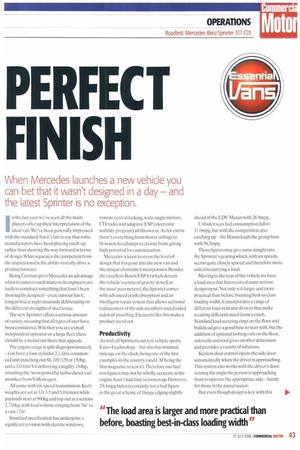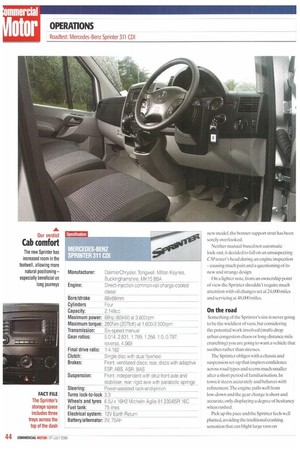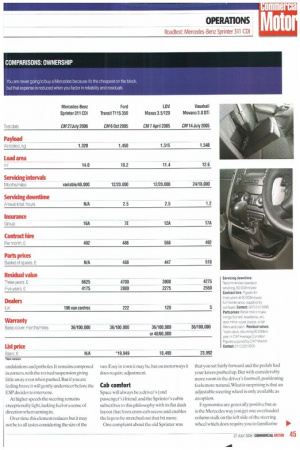PERFECT FINISH
Page 43

Page 44

Page 45

Page 46

If you've noticed an error in this article please click here to report it so we can fix it.
When Mercedes launches a new vehicle you
can bet that it wasn't designed in a day — and
the latest Sprinter is no exception.
I1 n the last year we've seen all the main ; players offer up their interpretation of the ideal van, We've been generally impressed with the standard, but it's fair to say that some manufacturers have been playing catch-up rather than showing the way forward in terms of design. What separates the competent from the inspirational is the ability to really drive a product forward.
Being German gives Mercedes an advantage when it comes to such matters; its engineers are loath to construct something that hasn't been thoroughly designed — even, rumour has it, lying in bed at night anxiously deliberating on the different strengths of steel to use.
The new Sprinter offers a serious amount of variety, meaning that all types of user have been considerecl.Whether you are a small independent operator or a large fleet, there should be a model out there that appeals.
The engine range is split disproportionately —you have a four-cylinder 2,1-litre commonrail unit punching out 88,109,129 or 150hp, and a 3.0-litre V6 delivering a mighty 184hp, wrestling the most powerful turbo-diesel van' moniker from Volkswagen.
All come with six-speed transmission. Kerb weights are set at 3.0,3.5 and 5.0 tonnes while payloads start at 900kg and top out at a serious 2,710kg, with load volume ranging from 7m to a vast 17m3.
Standard specification has undergone a Significant revision with electric windows, remote central locking, wide-angle mirrors. CD/radio and adaptive ESP (electronic stability program) all thrown in.As for extras there's everything from thorax airbags to hi-xenon headlamps to choose from, giving high potential for customisation.
Mercedes is keen to stress the level of design that has gone into the new van and the unique elements it incorporates. Besides the excellent Bosch ESP 8 (which detects the vehicle's centre of gravity as well as the usual parameters), the Sprinter comes with advanced crash absorption and an intelligent repair system that allows sectional replacement of the side members and divided sidewall panelling. Elements like this make a product stand out.
Productivity As with all Sprinters, our test vehicle sports Euro-4 technology — but also has minimal mileage on the clock, being one of the first examples in the country (and CM being the first magazine to test it).Therefore our fuel test figures may not be wholly accurate as the engine hasn't had time to loosen up. However, 29.4mpg laden is certainly not a bad figure in the great scheme of things, edging slightly ahead of the LDV Maxus with 28.9mpg.
Unladen sees fuel consumption fall to 31.0mpg, but with the competition also catching up — the Maxus leads the group here with 36.2mpg.
These figures may give some insight into the Sprinter's gearing which, with six speeds, seems quite closely spaced and therefore more suited to carrying a load.
Moving to the rear of the vehicle we have a load area that has received some serious design input. Not only is it larger and more practical than before, boasting best-in-class loading width, it incorporates a range of different load-restraint devices that make securing different-sized items a cinch. Standard load securing rings on the floor and bulkhead give a good base to start with, but the addition of optional lashing rails on the floor, sidewalls and roof gives another dimension and provides a variety of solutions.
Keyless door control opens the side door automatically when the driver is approaching. This system also works with the driver's door, sensing the angle the person is approaching from to operate the appropriate side— handy for those in the parcel sector.
But even though design is key with this new m.odel, the bonnet support strut has been sorely overlooked.
Neither manual-based nor automatic lock-out, it decided to fall on an unsuspecting CM tester's head during an engine inspection —causing much pain and a questioning of its new and strange design.
On a lighter note, from an ownership point of view the Sprinter shouldn't require much attention with oil changes set at 24,000 miles and servicing at 48,000 miles.
On the road Something of the Sprinter's size is never going to be the wieldiest of vans, but considering the potential work involved (multi-drop urban congestion chaos or long-distance mile crunching) you are going to want a vehicle that soothes rather than stresses.
The Sprinter obliges with a chassis and suspension set-up that inspires confidence across road types and seems much smaller after a short period of familiarisation. In town it steers accurately and behaves with refinement.The engine pulls well from low-down and the gear change is short and accurate, only displaying a degree of hesitancy when rushed.
Pick up the pace and the Sprinter feels well planted, avoiding the traditional crashing sensation that can blight large vans on undulations and potholes. It remains composed in corners, with the revised suspension giving little away even when pushed. But if you are feeling brave it will gently understeer before the ESP decides to intervene.
At higher speeds the steering remains exceptionally light, lacking feel or a sense of direction when turning in.
Over time this element reduces but it may not be to all tastes considering the size of the van. Easy in town it may be, but on motorways it does require adjustment.
Cab comfort
Space will always be a driver's (and passenger's) friend, and the Sprinter's cabin subscribes to this philosophy with its flat dash layout that frees cross-cab access and enables the legs to be stretched out that bit more.
One complaint about the old Sprinter was that you sat fairly forward and the pedals had your knees pushed up. But with considerably more room in the driver's footwell, positioning feels more natural. What is surprising is that an adjustable steering wheel is only available as an option.
Ergonomics are generally positive but as is the Mercedes way you get one overloaded column stalk on the left side of the steering wheel which does require you to familiarise with its functions. Secondary controls are harboured on the central console and are simple in their layout except for the heater direction switch, which may confuse.
What is easy to see is the improved storage which takes into account the changing needs of the modern driver. While once space for a clipboard and newspaper would do, now you need room for a plethora of equipment and the Sprinter obliges.
There are the mandatory door bins, but situated across the top of the dash are three evenly sized storage trays that provide excellent stowage space:above the dash are two separate trays.
The Mercedes is well insulated from the outside world, keeping at bay other traffic and road and wind noise. But it can't suppress one clement: the engine. Compared to our engine of the moment-the Fiat Multijet as seen in the latest Ducatothe Sprinter's unit sounds gruff. giving the impression that it would rather relax than have to be called on in any way. Giving the level of technology involved, this is a surprising negative. •
























































































































































































